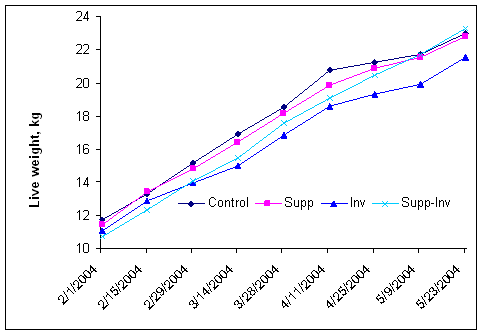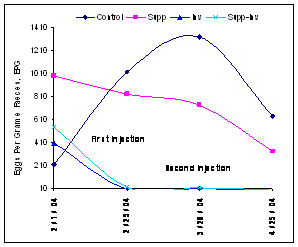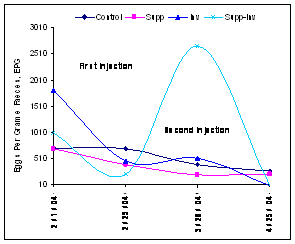Supplementation of Kapok tree foliage and Ivomectin injection on growth rate and
parasite eggs in faeces of grazing
goats in farmer households
Theng Kouch, T R Preston and Hun
Hieak
UTA (Cambodia),
POB 2423, Phnom Penh, Cambodia
thkouch2002@yahoo.com
Introduction:
In Cambodia, mostly goats are owned by small-holder farmer,s who raise them for meat. Usually, goat production depends on natural pasture. The traditional management system for goat production has consisted of day-time grazing and housing usually in a pen with raised floors at night-time (Sorn San 2002). Due to natural disasters, especially flooding, the natural pasture area decreases and/or there is no grazing area. Another problem is the high incidence of intestinal parasites (Theng Kouch et al 2003b). In the humid tropics especially in the SE Asia region, the grazing ruminants encounter a high rate of internal parasite infestation (Waller 1997b; Kochapakdee et al 2001). In these cases, goat production is reduced. Some farmers decide to stop raising goats, while some try to find tree leaves to feed their goats.
The use of foliage from trees and shrubs in animal nutrition has focused the attention of many researchers, due to the fact that these feed resources are locally available, perennial sources of feeds (Singh 1995; Leng 1997), rich in protein and particularly appropriate for small ruminants (Chen et al 1992; Norton 1994; Kaitho 1997; Seng Sokerya and Rodriguez 2001). In this connection, the kapok tree (Ceiba pentandra) is a multipurpose plant that could be successfully used in goat production in Cambodian conditions of animal husbandry, due to the fact that their agronomy is well known in practice by the farmers and, on some occasions, have been given to ruminants for feeding purposes (Nguyen Thi Hong Nhan 1998; Theng Kouch et al 2003b).
In the study reported by Theng Kouch et al (2003b), the protein content of the leaves and foliage of the kapok tree was18.6% and 17.9% in DM. Nguyen Thi Hong Nhan (1998) reported that the protein content in the foliage DM was 14.3%; DM digestibility in growing goats fed the foliage as the sole diet was 76% and growth rates (74 g/day) were similar to what was obtained with foliage of Leucaena.
According to Theng Kouch et al (2003b), the growth rate of goats in village condition is 50g/day and 20g/day, before and after flooding. This report showed that farmers often supplemented their goats with foliages from the kapok tree and manila tamarind.
Objective:
This research proposal aims to evaluate relative effectiveness of anthelmintic application and feeding of foliage from the kapok tree; and it is a part of development in using available local feed resources, to encourage farmers who raise goats, increase goat production and also income.
- Using available local feed resources for goat raising.
- Encouraging goat raisers
- Increasing goat production of farmers
- Improve the well-being of rural poor.
Hypothesis
The hypothesis to be tested is:
- The supplementation with kapok tree and Ivomectin injection will give the same result in control of intestinal parasites and growth of goats under farmer conditions, and both will be better than grazing alone
Material and Methods:
Location and duration
The experiment was conducted with farmers who are living in Pearm Okgna Ong commune, Lvear Em district in Kandal Province, in the eastern part of Phnom Penh city, about 25 km away.
This research will be over 8 months including the experimental preparation, commencing on 1 January 2004 and finishing in August 2004.
Experimental design:
The goats are kept in traditional management, by grazing at day time and in
the pen at night time. The experiment has 4
treatments: G: control of grazing only, GS: supplement with foliage
of kapok tree in the late afternoon and evening; GI: Ivomectin
injection; and GSI: Both, supplementation with kapok tree and
Ivomectin injection. There are 3 replications (three farmers) for
each treatment (total of 12 farmers), and 2 castrated male goats to
each farmer (total 24 goats). The supplemention of kapok foliage is ad libitum; injection with Ivomectin
is applied according to
live weight every three months.
The design is a 2*2 factorial arrangement as follows:
- Ivomectin injection: The first factor with 2 levels, with and without injection
- Diet: second factor with 2 levels, with and without Kapok tree foliage supplementation
The individual treatments are:
- G : Grazing of natural grass only (control)
- GS : Grazing of natural grass and supplement with kapok tree foliage
- GI : Grazing of natural grass and Ivomectin injection
- GSI : Grazing of natural grass and supplement with kapok tree foliage and Ivomectin injection
Animals:
24 male goats were purchased from local farmers at about 3 months of age and around 10 kg live weight. They were blocked according to live weight and the treatments allocated within blocks (n=3).
Supplementation:
The kapok tree foliage was given fresh after collecting by the farmers. It was offered to the goats by hanging in the pen wall, or in a similar way as traditionally used by the farmers.
Ivomectin Injection:
The injection was applied in the beginning of the experiment and repeated every two months.
Measurements:
Samples of the kapok tree foliage are analyzed at intervals (every month), first separating into leaves and stems which will be weighed to estimate proportions, and samples of each analysed for DM, N, Ash (AOAC 1990) and water extractable DM and N (Ly and Preston 1997)
Goats are weighed every two weeks and growth rate calculated by
regression of live weight on time in days. Feed intake of the kapok
foliage will be recorded.
Parasite eggs:
The parasite eggs were counted every month by collecting faces
from rectum, and using microscope and saline
solution.
Statistical analyses:
The data will be analyzed by analysis of variance (ANOVA) using the General Linear Model (GLM) of the MINITAB software version 13.1 (Minitab 2000). Sources of variation are treatments, blocks and interaction treatments*blocks and error.
Preliminary results
Through 4 months observation, it shown that the growth performance (Figure 1) of goats that received both supplementation and injection seem to be faster; while the supplementation and injection alone were not different from the control once. This, because of this period, January - April the natural pasture was available, goats can graze around the lake, so after returning home they could not eat more supplementation.
For my expectation, I hope that the supplementation will be effective from May, because at that time the lake will be filled with water that will decrease the natural pasture; while the parasite seem to be low effect (Figure 2).
Below, are the preliminary data from Feb-May.
|
|
|
Figure1: Growth curves of the goats |
|
|
|
|
|
Coccidia |
|
Figure 2: Numbers of parasite eggs in faeces |
|
![]()
![]()
![]()
References
AOAC 1990 Official methods of Analysis. Association of
Official Analytical Chemist. 15th edition (K Helrick
editor). Arlingtonpp1230
Chen C P, Halim R A and Chin F Y 1992 Fodder trees and
fodder shrubs in range and farming systems of the Asian and Pacific
region. In: Legume trees and other fodder trees as protein sources
for Livestock (A. Speedy and P.L Pugliese, editors). FAO Animal
Production and Health Paper No. 102 p 11-22
Hansen Jørgen and Perry Brian 1994 The epidemiology
diagnosis and control of helminth parasites of ruminants,
International Laboratory for Research on Animal Diseases, Nairobi,
Kenya
KaithoR J 1997 Nutritive value of browses as
protein supplement to poor quality roughages. PhD thesis.
Wageningen Agricultural Univesity. Wageningen
KochapakdeeS, Choldumrongkul S, Saitahnoo S and
Pralomkran W 2001 The effect of internal parasite on the grow
of crossbreed goat under village environment in Southern of
Thailand, PSU goat research publication, pp 285-290
Leng R A 1997 Tree foliage in ruminant nutrition. FAO
Animal Production and Health Paper No 139. Rome pp
100
Ly J and Preston T R 1997 An approach to the estimation
of washing losses in leaves of tropical trees. Livestock Research
for Rural Development 9(3):5-9
Nguyen Thi Hong Nhan 1997 Effect of sugar cane
juice on milk production of goats fed a basal diet of jackfruit
(Artocarpusheterophyllus) leaves. In Proceedings
Regional Seminar-Workshop on Better use of locally available feed
resources in sustainable livestock-based agricultural systems in SE
Asia (Editors: T R Preston and Kenji Sato). FAO Project
GCP/RAS/143/JPn; Ho Chi Minh City (pp: 62-65)
Norton B W 1994 Tree legumes as dietary supplements for
ruminants. In: Forage tree legumes in tropical agriculture (R.C.
Gutteridge and P.M. Shelton, editors). CAB International.
Wallingford p 202-215
Seng Sokerya, Rogriguez Lylian 2001 Foliage from cassava,
Flemingia macrophylla and bananas compared with grasses as forage
sources for goats: effects on growth rate and intestinal nematodes.
Livestock Research for Rural Development (13) 2: http://www.cipav.org.co/lrrd/lrrd13/2/sok2132.htm
Seng Sokerya and Preston T R 2003 Effect of grass or
cassava foliage on growth and nematode parasite infestation in
goats fed low or high protein diets in confinement. MSc. thesis,
Swedish University of Agricultural Sciences, Uppsala
Singh R V 1995 Fodder production from tropical forests in
Asia and the Pacific Region. FAO Regional Office for Asia and the
Pacific Publication 1995/16. Bangkok pp 65
Sorn San 2002 Survey of the Distribution, Management,
Marketing and Constraints of Goat Production in Cambodia. Goat
Project report for ILRI IFAD TAG 433
Theng Kouch, Nam Noch, and Preston T R 2003b.
Observations on goat raising system of farmers along the Mekong
river on production, reproduction and feed. MSc. thesis, Swedish
University of Agricultural Sciences, Uppsala.


